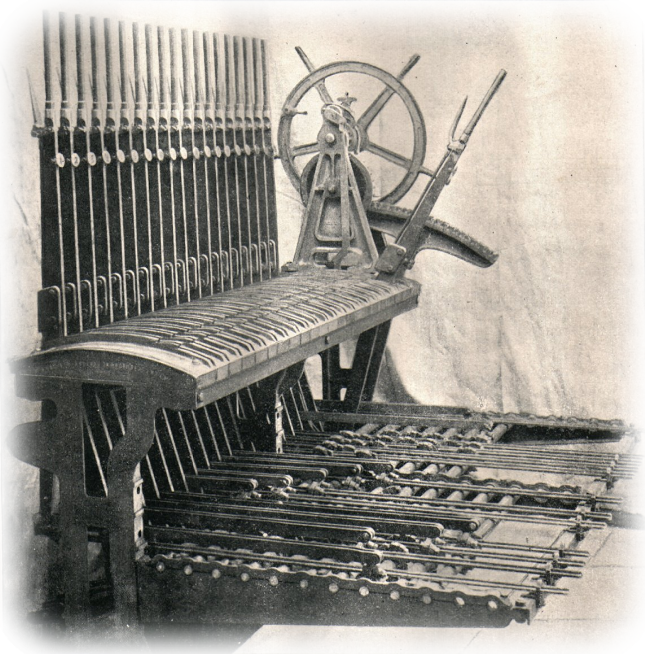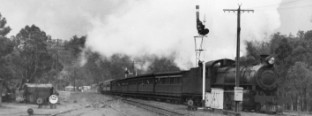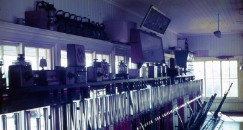Lever Frames
LEVER FRAMES

Since the late 1890s the W.A.G.R.'s preferred signalling contractor was McKenzie and Holland.
The company's No. 9 Pattern lever frame was selected for use in most of the state's signal boxes and cabins.
The reasons for this choice was, multi-faceted but probably the fact that the robustness of the design, coupled with the fact that virtually no additional machining was necessary to assemble a working lever frame. The frames could be configured and maintained easily by workers with basic mechanical skills, only a few specialized tools and who only required a limited amount of specialised training. Also considered a valuable asset, was that this particular type of frame had what is known as a 4 1/2" pitch. The term 'pitch' being the distance between the centre of one lever to the centre of the next lever in the frame. By way of comparison, the Victorian Railways of Australia also used McKenzie & Holland lever frames, but the pitch of their frames was 5". This may not seem much, being a mere 1/2" more, but when one considers that in the larger signalling installations, which naturally required more levers, this required the building housing them to be much longer, hence more costly. Therefore, the W.A.G.R.'s choice enabled larger capacity of levers within somewhat smaller signal cabins. Whilst it is true that the McKenzie & Holland No. 9 Pattern lever frames formed the bulk of the lever frames in Western Australia, it was not the only type used, this author has found at least one example of a McKenzie & Holland No. 11 Pattern lever frame, complete with interlocking. The pitch of this frame seemed to be about 4", so was even more compact.
The components of the frames were very simple and basic. Using a typical 10 lever frame as an example - this would comprise of an iron casting at each end, between each of these two ends two bearing shafts were fitted, each shafts having been machined for the later fitting of levers at the correct (4 1/2") spacing for this No 9 pattern of frame. Finally, two lenghts of angle iron were attached to the top of the frame castings onto which the required number of floor plates would be bolted between the levers. A Left hand and Right hand end floor plate completed the leverframe in the operating floor area.
- The numbers are the lever numbers as seen in the lever frame with the levers (shown as Black circles) all shown in their normal position. Lever No. 7 does not control any equipment as it has no symbols below and is indicated as such by being enclosed within brackets. This would be indicated to the Signalman by the lever being painted white. Spare levers were typically bolted in the normal position to prevent them from being moved. Lever No. 8 is not provided, which is indicated by the brackets being empty. This is what was known as a Space in the line of levers;
- The verticle lines from and below each lever (No. 8 excepted), represent the T-Irons;
- The horizontal lines represent the interlocking shafts (known as rocking shafts due to the fact that they do not completely rotate). The number of these shafts depend on the number of levers and the amount of interlocking being provided.
- The 'X' at the intersection of a T-Iron and a Shaft, represents the location of a 'Soldier'. By way of example, with all levers being normal (being away from the Signalman). When looking at the chart, 'Soldiers' can be seen as located on levers Nos. 1, 2, 5 and 6. By way of explanation, lever No. 6, when pulled over to 'Reverse' (being near the Signalman), will cause the partial rotation of the first shaft in the interlocking tray.
- The 'R' symbols indicate (somewhat confusingly) the location of a lock which has been fitted to the rocking shaft and positioned so that it engages into the notch of the T-Iron to prevent that lever's movement. As the first shaft has two 'R' symbols along it's length (on levers No. 1 and 2), the partial rotation of this shaft, will then remove the locks from the notches and therefore 'Release' that lock on Levers No. 1 and 2 at the same time. Both levers 1 and 2 will still be prevented from movement however, as lever No. 5 will also have to be pulled in the same fashion as before to dis-engage the locks completely - this is done by Lever No. 5 'Releasing' the locks on the second shaft in the interlocking tray.
- With both lever Nos. 5 and 6 having been moved to the reverse position, they have both partially rotated the shafts by means of the Soldiers fitted to shafts 3 and 4 in the interlocking tray and engaged the locks positioned on those shafts further along the tray, the action causing the interlocking of levers 3, 4, 5 and 6.
- In order to return the levers to their normal position, one has to return them in opposite order of pull.
- This form of interlocking of levers provides essential safety and as the reader might gather from this simple example, signal cabins with a large numbers of levers had very complex interlocking charts.
The design of the McKenzie and Holland lever frame proved to be very adaptable to emerging railway signalling control technology. Such was the case when Sykes Lock and Block instruments were introduced in the early 1900's. For the first time on the WAGR system, Signalmen were prevented from placing starting signals to proceed until it was electrically released by the Signalman in the next signal cabin ahead, or in railway parlance 'in advance'. This was achieved by the connection of steel control rods from the instrument to the signal levers below floor level.
Application of Electro-Mechanical Interlocking.
The design also permitted the easy addition of electro-mechanical control, such as Gravity Locks which were introduced around 1911. These were an electric coil fitted above the back end of a 'T-Iron' which, when permitted to do so by the electrical interlocking, removed a metal lock from a specially cut notch in the 'T-Iron', thus allowing it to be moved. These items were typically used for simple track occupancy locking situations, meaning that should a track be occupied by a railway vehicle, then the lever controlling the points would be prevented from being moved. When first introduced, the electrical supply to these locks was controlled by two floorplate switches worked by the action of the catch handle rod at the rear of each lever - one switch was in the normal position and another in the reverse position of the levers between the levers in the Operating Floor area. These switches were still being used in many signal cabins until the end of their working lives. In practice, the floorplate switches in particular attracted the lint from the yellow dusters used by the Signalmen when working the levers and they were difficult to keep free of dust and dirt. Later, some signal cabins were provided a single steel foot button in line with the lever to be worked. In England, these floorplate switches or foot buttons were referred to as 'economisers'. When either of these types of switches were activated, and provided the track circuit was clear, the operator could hear the Gravity Lock 'pick' (engage) and therefore release the lever for movement.
COLOUR | USE | NOTES |
| RED | Signals | All Signal types including mechanical Distant Signals |
| BLACK | Points | Working trackwork points and / or crossings |
| BLUE | Facing Point Locks and / or Bar | Engages a locking device at the trackside of the above |
| BLACK and BLUE | Points and Facing Point Lock combined | Where a single lever is configured to control the functions of Blue and Black levers simultaneously |
| YELLOW | Permission Levers | Used for releasing trackside switchlocks or other remote lever frames |
| BROWN | Bolt Locks | A mechanical control of an external item of equipment |
| GREEN | Automatic Control Cut-Out Levers | Sometimes known as a 'Switch-In' / 'Switch-Out' or 'King' Lever |
| WHITE | Spare | Levers which are not currently in use |
- Levers 1 to 20 - Releasing numbers painted on the Right Hand Side of the levers with the release numbers being from Highest to Lowest
- Levers 21 to 40 - Releasing numbers painted on the Left Hand Side of the levers with the release numbers being from Lowest to Highest
- The first task to maintain the lever and catch-handles was to remove any trace of rust. This was done by a light touch with a fine grit wet and dry or fine sandpaper - the most important part if this procedure was to NEVER use the paper in circular motion around the levers as this left scratches in the steel which were hard to erase. The correct method, was that they had to be cleaned 'along the grain' of the steel - this term meaning that they had to be cleaned in an upward and downward manner. and polishing lever handles.
- The second task was to remove any trace of the rust remains with a cloth - NOT a lever duster, as any rough patches could 'catch' on the duster fabric.
- The third task was to use a burnisher to completely polish the steel. Burnishers were nothing more than a square piece of leather with metal rings attached to the edges which covered one entire surface -yes, it what was once known in olden days as 'chain mail' as used by medieval knights. The burnishing also had to be done 'along the grain' of the levers, and when completed, the result was a highly polished steel surface that not only shone like a mirror, but one could also read the reflection of a page of a book from its surface.
- Finally, a quick wipe-over with another cloth would ensure that no metal residue remained.
Information on this page has been researched and interpreted by Chris. J. E. French of SignallingWA
Graphics of interlocking are from former W. A. G. R. training materials as are original drawings.
Photos are as credited in the captions.
This page is copyright, and permission must be sought from SignallingWA before this page is used for any purpose other than personal education.


